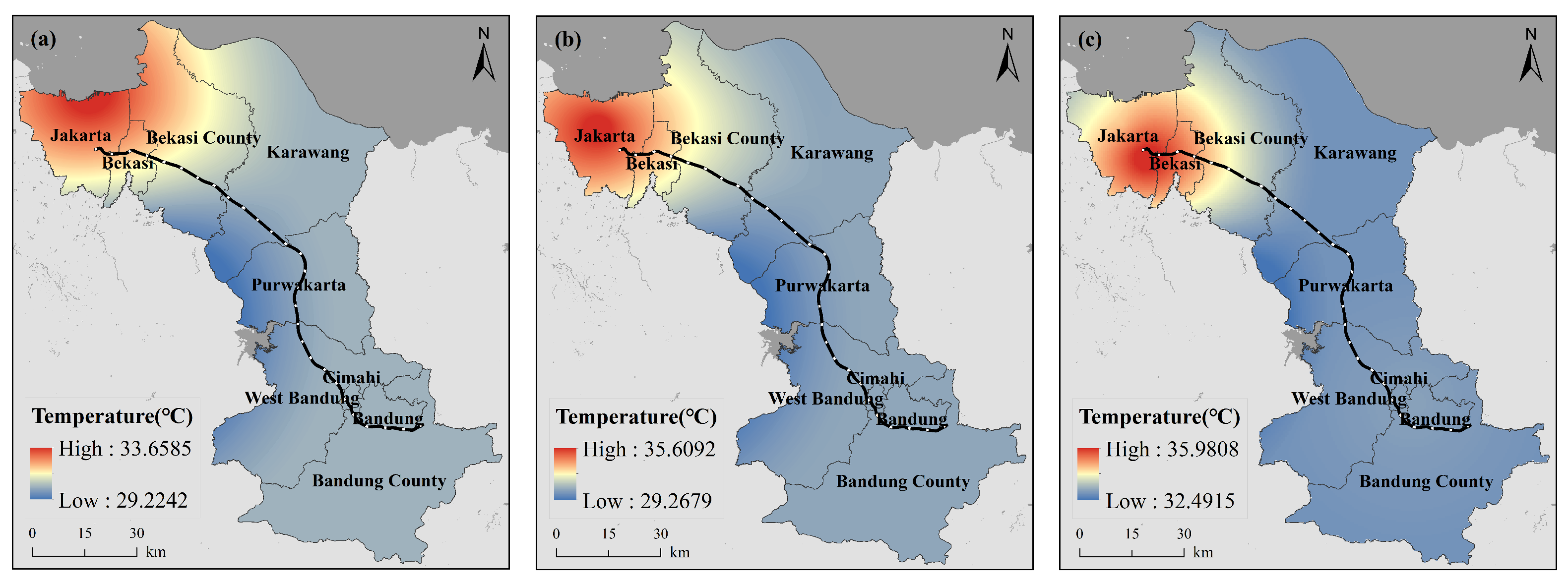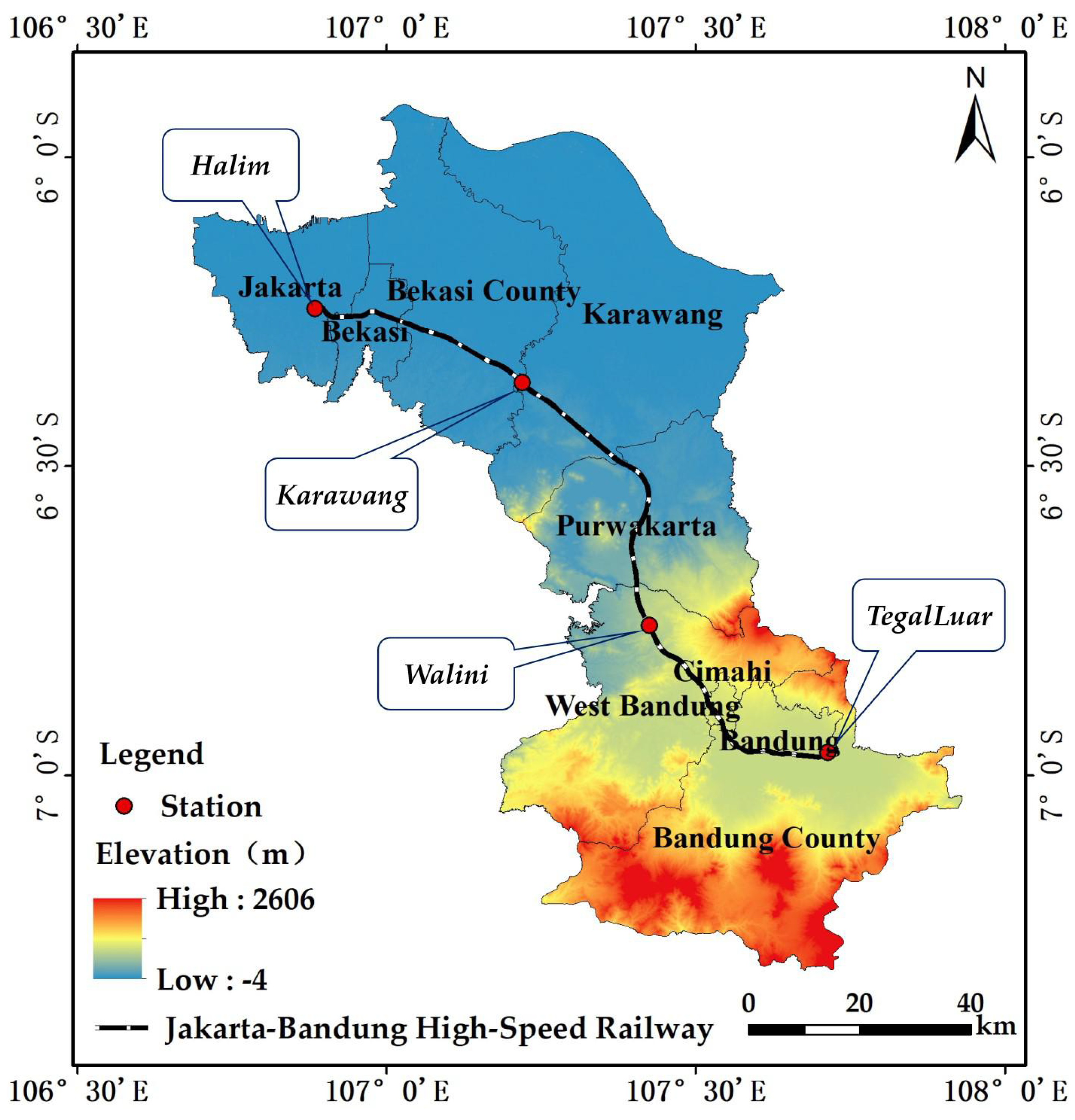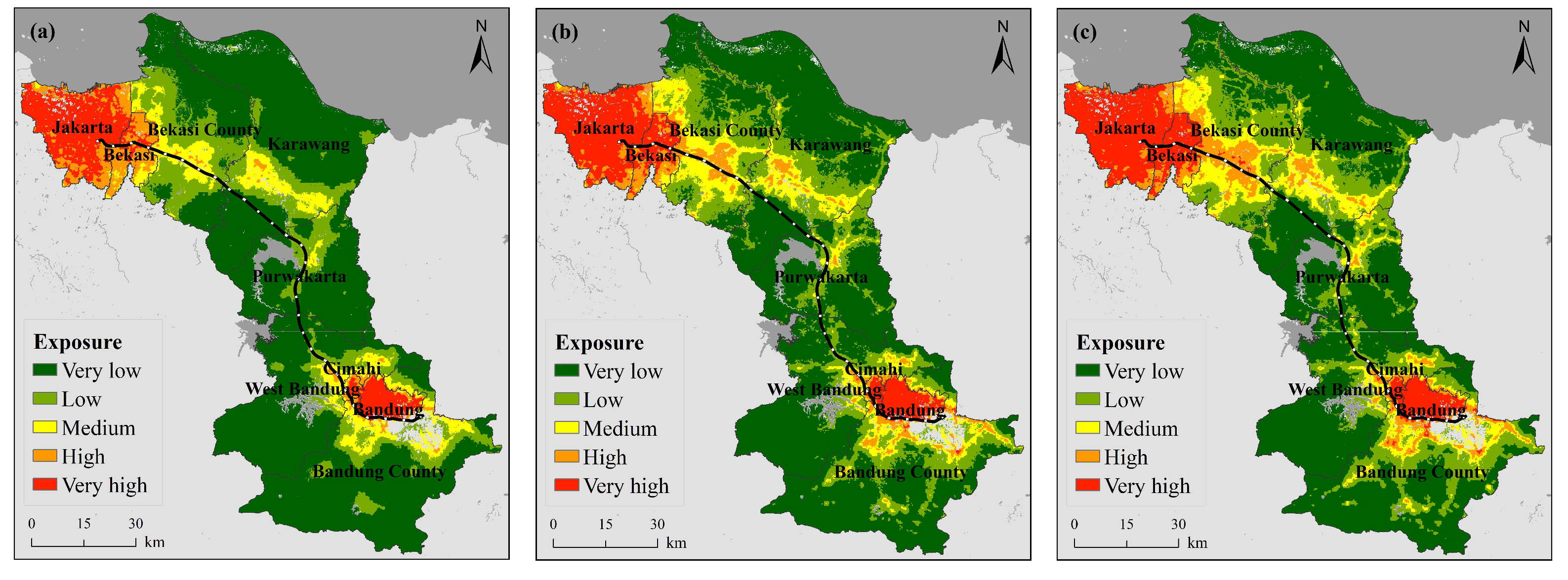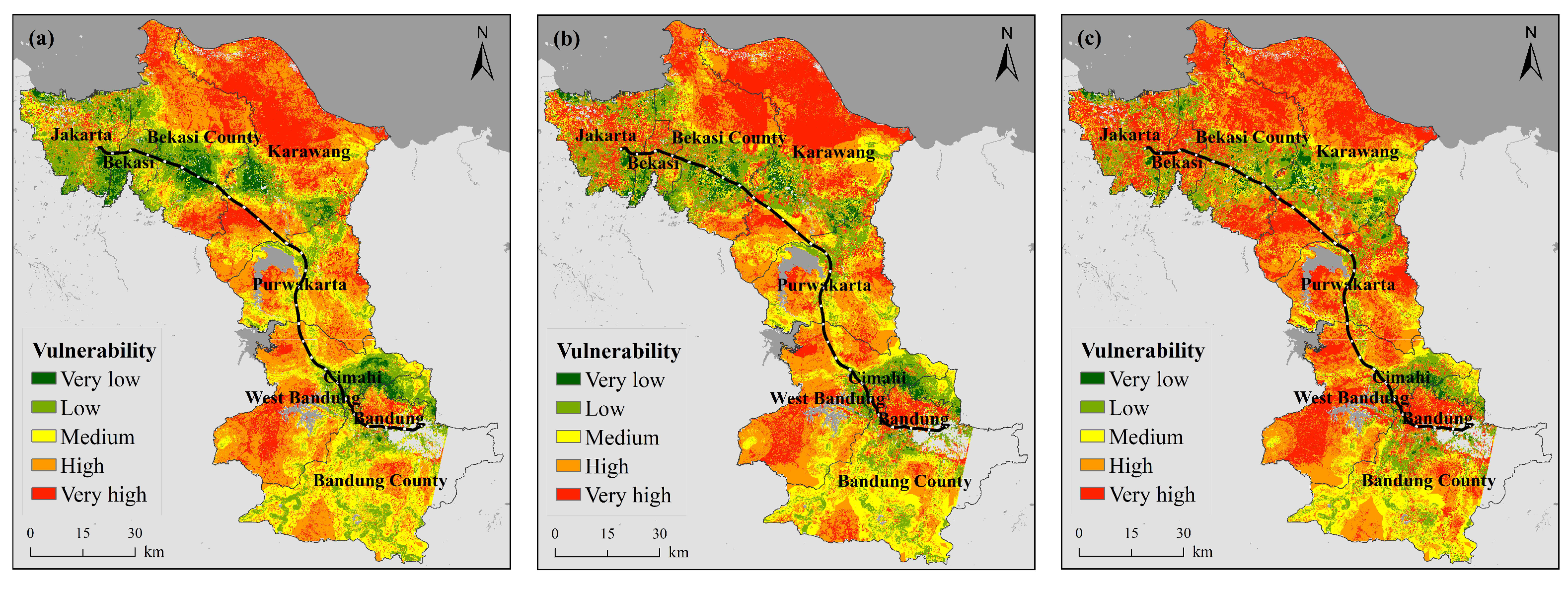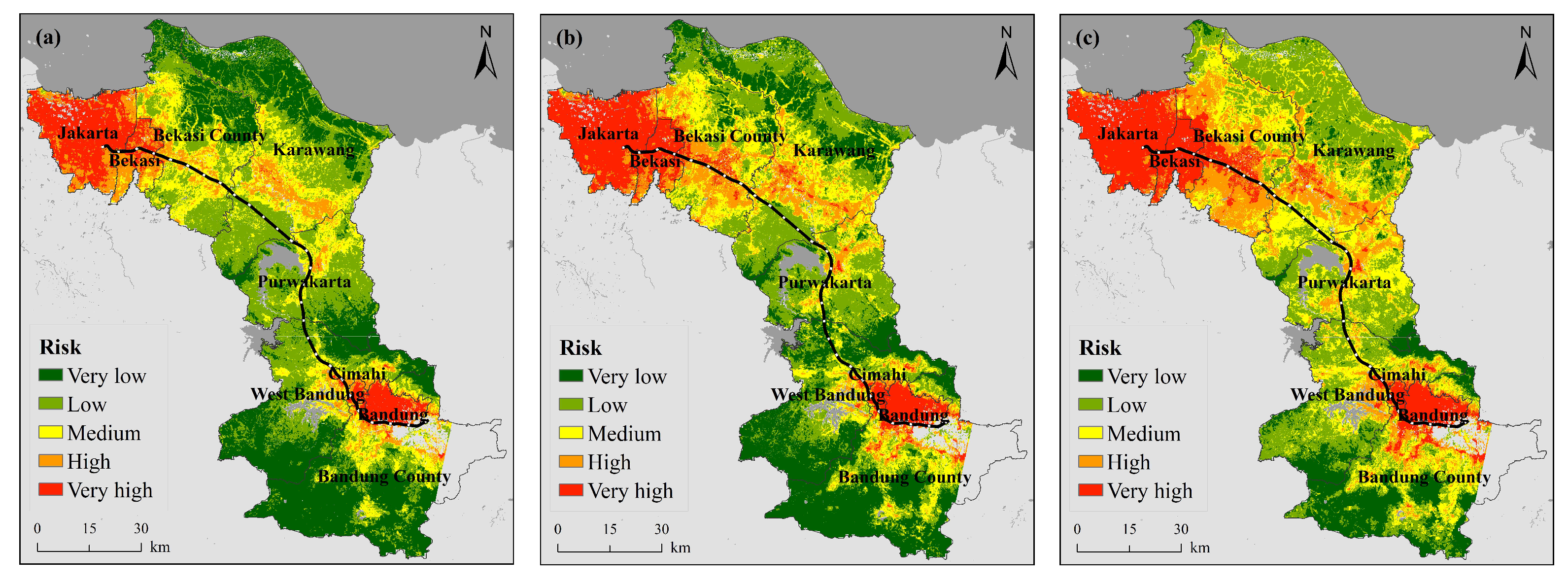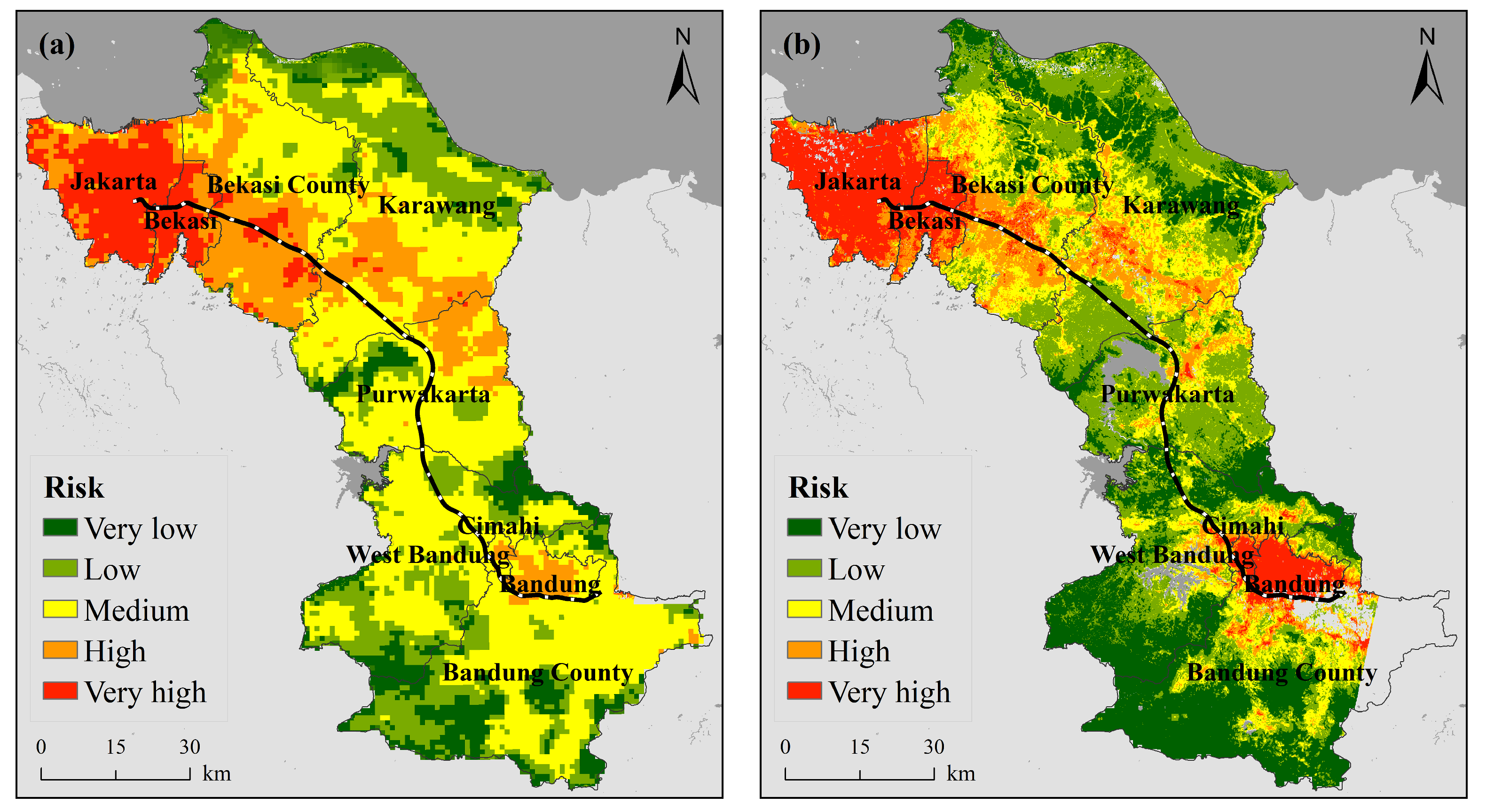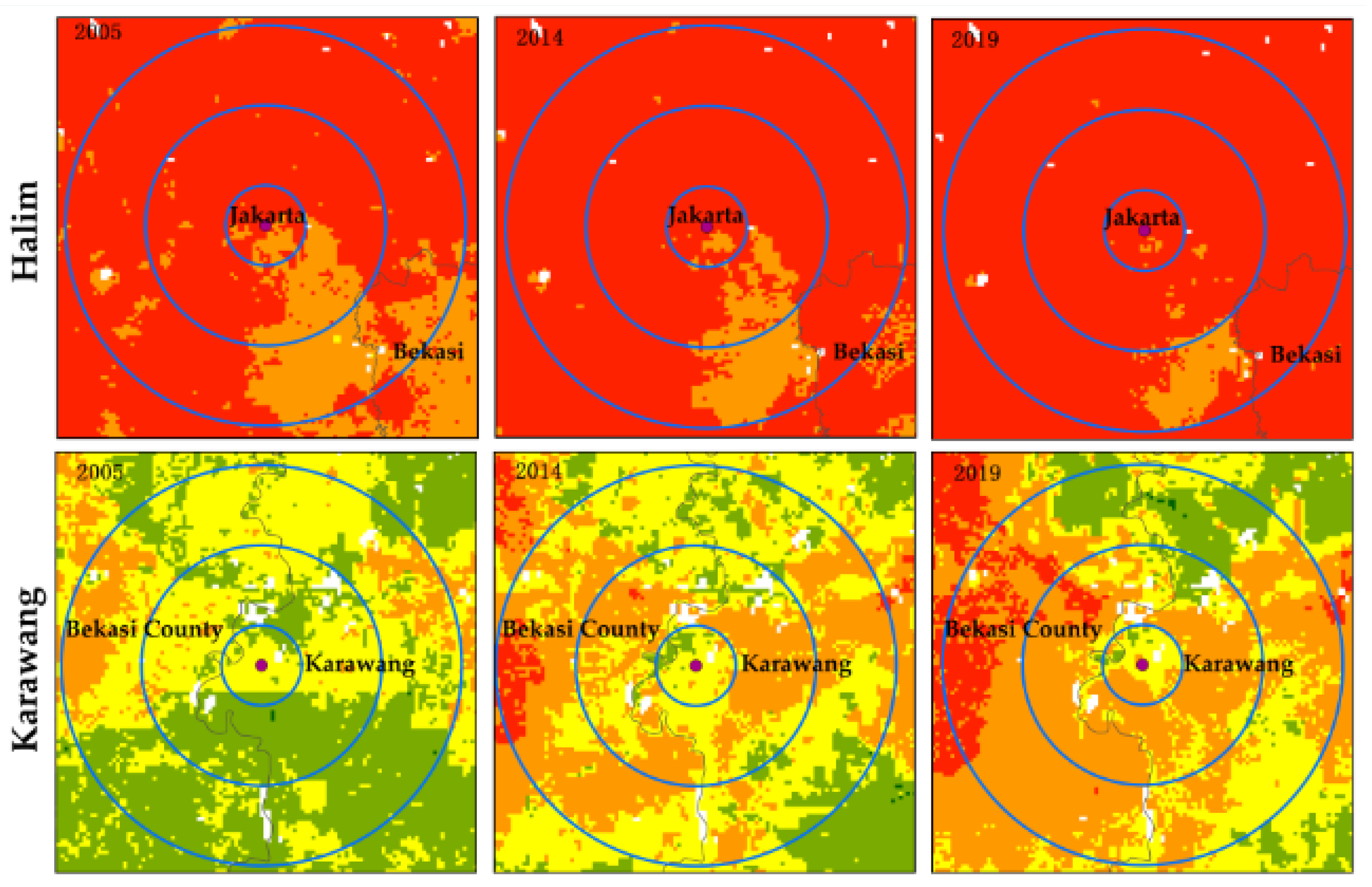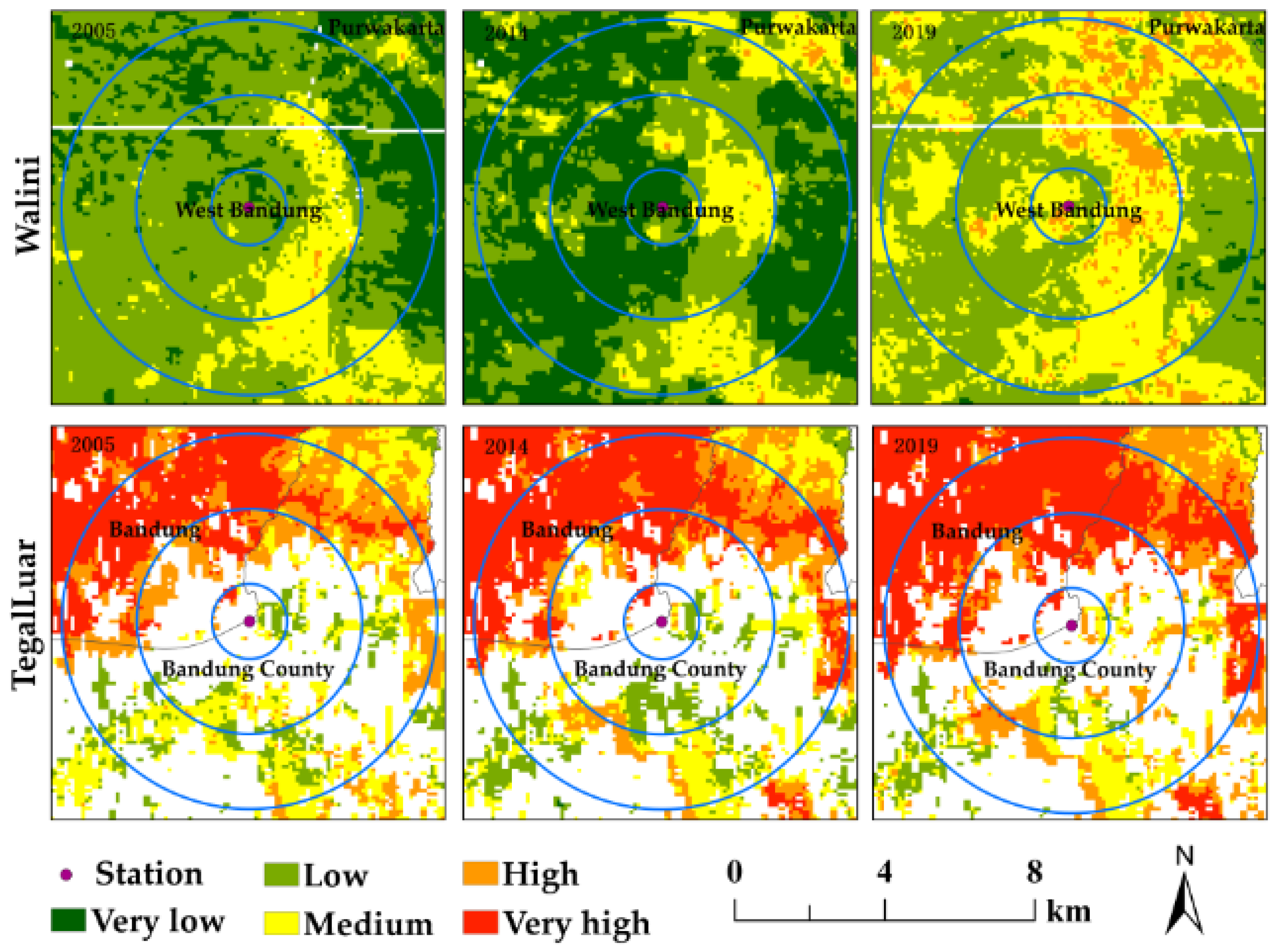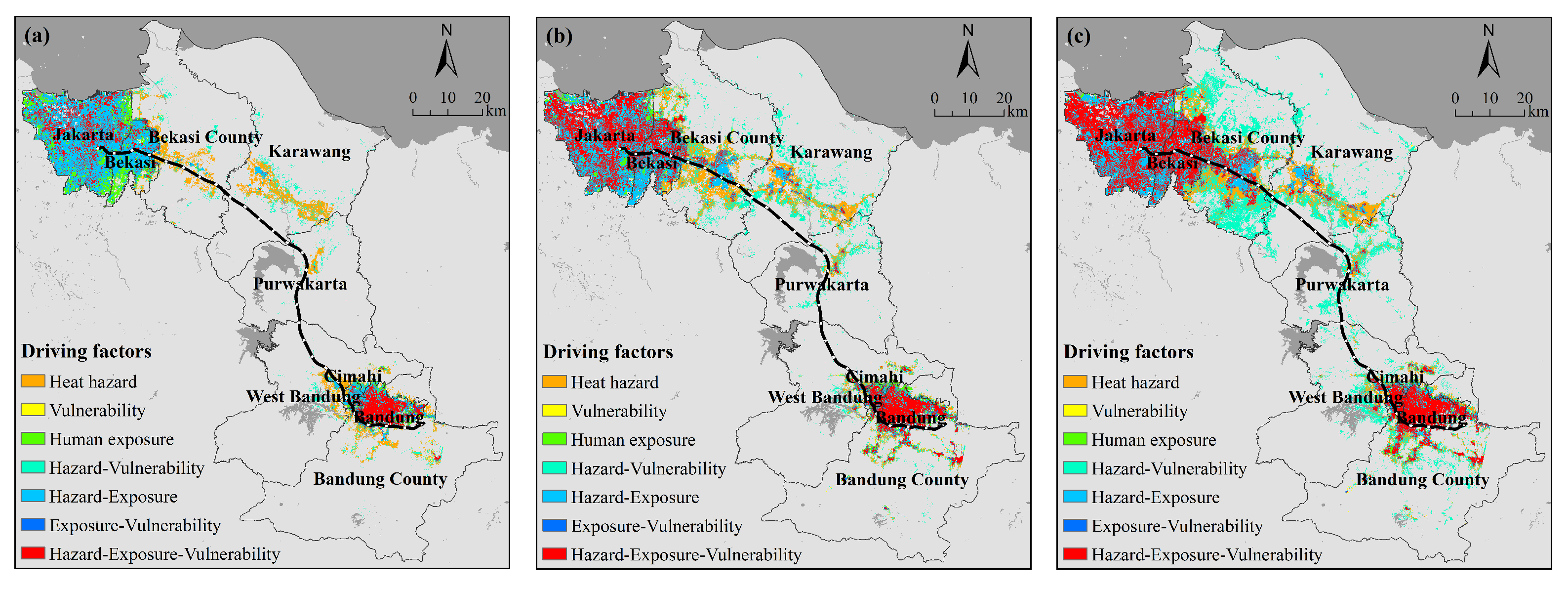1. Introduction
In the Intergovernmental Panel on Climate Change (IPCC) Special Report on Global Warming of 1.5 °C, it is estimated that human activities have caused approximately 1.0 °C of global warming over preindustrial levels, with a likely range from 0.8 °C to 1.2 °C [
1]. Global warming is projected to intensify heat wave events, with a trend toward an increased frequency, intensity and duration [
2,
3,
4]. A total of 70,000 people perished in a heat wave in Europe in 2003 [
5], and a heat wave lasting three weeks in Russia caused approximately 56,000 deaths in 2010 [
6], while a heat wave in Pakistan killed more than 200 people within a week in 2015 [
7]. In April 2016, heat waves occurred in several countries in Southeast Asia, severely affecting crop growth and causing social hardship [
8]. The direct adverse effects of heat waves also include: power shortages [
9,
10], agricultural losses [
11,
12], and infrastructure damage [
13]. The impact of heat waves on human health and global socioeconomic activities is becoming increasingly severe and is now the leading cause of weather-related illnesses and death globally [
5,
14]. Therefore, heat waves are highly valued in the field of extreme weather, and the identification and assessment of the heat wave risk (HWR) have become the basis and important foundation for disaster mitigation and development of emergency management responses.
The Jakarta-Bandung high-speed railway (JBHSR) is Indonesia’s first high-speed railway, connecting Jakarta with Bandung, and is one of the key nodes along the Belt and Road initiated by China, with an important demonstration and leading role [
15]. The JBHSR is located close to the equator, and the region remains hot year round. Regional disasters are frequent, with meteorological and hydrological disasters accounting for 77% of all disasters in Indonesia between 1815 and 2011 [
16], and among these disasters, heat waves represent one of the most frequent meteorological disasters. At present, there are few reports on heat wave studies in the area, with a notable lack of fine-scale HWR assessment results to scientifically guide local governments, people and construction companies in the development of effective HWR prevention and response measures. Moreover, high-speed railway construction certainly produces great demographic, economic and social development along the route, which can cause spatiotemporal HWR changes. Therefore, it is important to conduct HWR assessment in this region.
A review of the current literature on HWR assessment worldwide reveals the following problems: (1) In terms of the time scale, most of the studies on HWR changes at long time scales are based on meteorological station data, and only indicators of the heat wave intensity, frequency and duration are chosen [
17,
18,
19,
20,
21], or indicators such as the effective cumulative temperature calculated considering meteorological station temperature data [
22] to study heat waves in a particular region over decades. However, studies based on meteorological station data consider only one station to represent the temperature of the whole city, or when the study area is large, the variability in heat waves is mostly studied via interpolation of station-measured temperatures [
20,
21,
23]. Although the above methods can suitably analyze changes over time on a yearly scale, the spatial scale is coarse (10–50 km), and only analyses from the perspective of heat wave hazards have been conducted. This ignores the uneven distribution of the temperature within cities caused by the topography, natural environment and urban heat island effect and fails to reveal the spatial differences in temperature within regions. (2) In recent years, the accelerating urbanization process has led to further intensification of the urban heat island effect. Kazak utilized land use data to construct a decision support system and found that areas with a concentration of large cities have higher levels of potential UHI exposure [
24]. Numerous scholars have shown that urban heat islands have a synergistic relationship with heat waves [
25,
26,
27]. During heat waves, urban residents are exposed to more severe and sustained heat stress [
28], and the morbidity and mortality of residents are increased [
29,
30,
31]. Fischer considered urban models and found that heat stress in cities would be greatly increased during heat waves [
32]. Thus, humans, as the main bearers of heat waves are also increasingly affected by heat waves. In recent years, an increasing number of scholars have paid attention to the impact of heat waves on human health [
33,
34,
35]. Studies on the impact of heat waves on human health should consider not only the impact of heat on humans but should also include a comprehensive assessment of the HWR in conjunction with factors such as natural and socioeconomic environments [
5,
36,
37]. Estoque considered the land surface temperature (LST), population and economy factors [
33]. Jackson selected sociodemographic, ambient temperature distribution, and shelter availability factors [
36]. However, in this type of study, the risk of heat waves is usually studied for a single heat wave event or on a one-year time scale, and only the spatial distribution of high- and low-risk areas can be obtained. A multiyear (long time scale) HWR study provides a more realistic meaning, because it not only clarifies the spatial distribution of high- and low-risk areas but also identifies the overall HWR trends and the evolution of risk hotspots and predicts future risk trends. In conclusion, in regard to the spatiotemporal scale, the current research does not satisfy the realistic guidance needs of regional disaster prevention and mitigation.
The risk assessment along the JBHSR has not been studied until now. Only a few scholars have conducted some studies on the central cities (provincial capitals or national capitals) in Indonesia, covering a few themes, such as land use, urban heat island, and natural hazard vulnerability [
38,
39]. Relevant studies at the kilometer scale have been carried out for Indonesia regions in our previous work, which better represent the spatial differences in regional HWR and can be applied to regional disaster prevention and mitigation guidance. However, it is found that, spatially, the kilometer scale cannot reflect the spatial differences within a small region, and temporally, it cannot reflect the trend of risk changes and predict the future development trend of risk.
Therefore, this paper, after interviewing relevant experts many times, determines an index system for the HWR, applies Landsat data to obtain finer-scale LST data via inversion, and combines multisource fine-scale remote sensing data to carry out a study on the spatiotemporal changes in the HWR at the 100-m scale over the past 15 years (2005, 2014 and 2019). This study can provide a reference for regional disaster prevention and mitigation decisions, scientific warning and prevention systems of high-temperature risks and implementation of adaptation measures.
4. Discussion
Previous studies have shown that there is an urgent need for more spatial specificity in HWR assessment under a geospatial framework [
5,
58,
59]. In this study, the remote sensing-based HWR assessment method can demonstrate the distribution of risk at the pixel level. Moreover, this paper conducts research based on the 100-m scale, which effectively improves the spatial granularity of the data compared to existing studies (in which provinces, cities, or counties were the smallest research units), and the maps are more informative and intuitive, which is more helpful for communicating and understanding specific human risks. To the best of our knowledge, this is the first HWR map along the JBHSR, and the first spatial and temporal map of HWR at the 100-m scale in the world based on the region along the high-speed railway and taking into account the distribution of the natural and socio-economic environments. With limited cost, time, and labor, this study is particularly valuable in guiding local decision makers to proactively develop adaptation strategies for mitigation interventions and climate impacts [
60]. The method can also provide new ideas for HWR assessment in countries along the Belt and Road.
In the absence of spatially explicit population distributions, previous studies have opted to use a proxy index, called the elevation-adjusted human settlement index, which can be produced by using a set of remotely sensed data, including a nighttime lights dataset, a vegetation index, and a digital elevation model [
5,
14,
41]. Fortunately, the downscaling of population data has improved in recent years. Global gridded population data are now available at various spatial resolutions and time points. For instance, WorldPop provides gridded population data products with a spatial resolution of 100 m for the corresponding year [
44]. Estoque et al. have demonstrated that this dataset has a significant positive correlation with census data (
= 0.9926) [
33]. This paper takes full advantage of this dataset to obtain finer spatialized population data, which not only improves the accuracy of the overall risk assessment but can also effectively overcome the difficulty of obtaining detailed socioeconomic statistics for many countries, and can provide a new way to obtain data for HWR assessment in the countries along the Belt and Road.
Most previous studies have focused on quantifying heat vulnerability and heat health risks in urban environments. This study takes a different approach by selecting the strategically important area along the JBHSR, which has a complex landscape and passes through towns with different levels of development and different sociodemographic population characteristics. The 2005 vulnerability map of the region along the JBHSR (
Figure 5) is consistent with studies by Sheridan and Dolney [
61], Wu et al. [
62], Henderson et al. [
63] and Hu et al. [
5] that show that rural populations are more vulnerable to extreme heat than urban populations. Urban areas are usually better able to adapt to extreme heat than rural areas, probably because they have higher socioeconomic status and better medical resources [
62]. In addition, a population cross-sectional survey in Guangdong Province, South China, showed that rural populations have very low perceptions of HWR and rarely take adaptive measures during heat waves [
64]. The vulnerability maps for 2014 and 2019 (
Figure 5) for this study area show high vulnerability not only in rural areas but also in urban areas, which is consistent with the study by Aubrecht and Ozceylan [
65], which showed high vulnerability in the U.S. Capital Region. Vulnerability shows an overall trend of increasing over time. The explanations of this trend may be diverse: first, as cities grow, green spaces decrease and impervious surfaces increase, making urban heat islands more severe; second, due to data limitations, road and hospital data, the constant 2014 data (OpenStreetMap) was used, which has an impact on the assessment of dynamic changes in vulnerability.
For indicator weights, this paper uses a combination of equal weights and relative weights. Although the literatures present different contributions of environmental, demographic, and socioeconomic indicators, there is not yet an accepted standard weight for each indicator [
66,
67]. Therefore, most previous studies have assumed equal importance and set equal weights. In this paper, equal weights are used within specific risk components. In addition, in calculating the risk, this paper uses a relative weight based on expert judgment and is obtained by Estoque et al. through a questionnaire filled out by experts in several fields, with a certain degree of objectivity and reliability [
33].
However, there remain certain aspects that should be improved in this paper. (1) In terms of hazards, this paper employs the LST, which only considers the effect of temperature on humans, but the effect of heat waves on humans is also influenced by the relative humidity and wind speed [
28]. Furthermore, the hazard indicators selected in this paper only include the heat wave intensity, while the heat wave frequency and duration are also crucial in the heat wave process. In future studies, we will consider apparent temperature data to characterize heat wave hazards [
68], and we will add frequency and duration indicators. (2) The lack of detailed data also imposes some limitations on the study presented in this paper, for example, heat sensitivity data (e.g., people’s physical health status) or adaptive capacity data (e.g., air conditioning ownership, education or literacy rates, etc.). However, all of these indicators mentioned, including those considered relevant but not mentioned, need to be explored and will be considered for inclusion in future updates of this study once city-level or more detailed-level data are available. (3) Heat waves can be fatal in severe cases, so the number of heat-related deaths or the incidence of heat-related mortality best validates the HWR [
5,
21], but these data are currently difficult to obtain. The extraction of heat-related mortality data from all-cause mortality data and mortality data related to various diseases will be a key focus of future HWR studies. (4) Although Landsat data provide a high spatial resolution and can be applied in fine-scale studies, due to their low temporal resolution, the two images obtained in this paper pertaining to the same period (the same day) do not completely cover the entire study area, resulting in a missing lower right corner of the research results in this study. Therefore, data acquisition at a high spatial resolution and high coverage will also become a focus of further exploration, and future research will attempt to solve this problem based on MODIS data, combined with downscaling algorithms. (5) The importance of each assessment factor (population of elderly individuals, population of young individuals, economic level, hospital/road distribution, vegetation/water coverage, impervious surface) was not differentiated when conducting the vulnerability assessment. In fact, each factor contributes differently to the heat wave risk [
21,
41]. However, there is currently no uniformity in the determination of the weights of each indicator in heat wave risk evaluation. How to determine more objective and reasonable indicator weights when each influencing factor has a different degree of influence on the overall risk evaluation will also be the focus of future research on risk assessment.
Furthermore, (1) The resolution of NTL data used in this paper is 1 km. Chen published the latest NTL data, which is a long time series with 500 m resolution [
69]. In future research, the 500 m resolution NTL data will be used to replace the 1 km NTL data, which will further improve the evaluation accuracy. (2) The spatial advantage of surface temperature data is more prominent; however, its temporal accuracy is lower and it is more seriously affected by clouds. The time series of meteorological station data is more complete, but its spatial accuracy is limited and cannot reflect the spatial variability of temperature in a region [
23,
48]. In the future, we will try to combine RF (Random Forest) and LSTM (Long Short-term Memory) algorithms to build a fine-scale temperature dataset with a complete time series. Using this dataset to calculate heat waves will also increase the accuracy of the data to a certain extent, thereby improving the accuracy of the risk assessment results. (3) The study of spatiotemporal changes in the HWR over long time series is of great practical significance in revealing the evolution of risk hotspots, HWR development trends and disaster response and prevention patterns. In future studies, the time series will be further increased to include years before 2005 (2000, 1995, 1990, etc.) to explore the spatiotemporal variation in the HWR over a longer time series. Given a longer time series, the impact of additional sensitivity indicators (GDP, population, etc.) on the HWR can be further clarified. Moreover, we will perform a long-term follow-up assessment of the HWR in the region after JBHSR completion in the future. This study can provide a good reference case for research on the changes in HWR caused by regional development along high-speed railways in more countries, which is highly important. (4) Combined with the changes in population size and GDP per capita over the last 50 years in Indonesia, it is clear that the influencing factors have notably changed over the last 50 years and that with rapid socioeconomic development, the rate of increase in the population size and GDP will further increase and heat waves will become more severe. Therefore, in future HWR studies, the analysis frequency should be increased, and a time interval of three years, two years, or even one year should be chosen in the examination of spatiotemporal change patterns. (5) Combined with previous studies, it is predicted that the excess mortality of the population of elderly individuals due to heat waves will notably increase against the background of global warming [
14,
29]. However, with social progress and the increasing availability of healthcare resources, population aging is becoming a common phenomenon worldwide. Therefore, in future studies on HWR assessment, there is a need to not only analyze the overall risk of elderly individuals as a highly sensitive population group but also to further explore the relationship between heat and excess mortality among elderly individuals and to formulate scientific recommendations to mitigate the impact of heat waves on this demographic group.
5. Conclusions
Assessments of extreme heat vulnerability and risk are mostly studied for a single heat wave or on a one-year time scale, but HWR assessment on long time scales is rarely carried out. Within the general framework of the main determinants of risk (hazard, exposure, and vulnerability), we conducted a comprehensive, spatially explicit, and long time series analysis to assess the HWR and the spatiotemporal variability of the risk along the JBHSR. Multi-sensor remote sensing data, demographic and socioeconomic data, and geographic information system (GIS) technology were used to calculate the HWRI and to develop a raster map of the spatial distribution of HWR at the 100-m scale for the last 15 years (2005, 2014, and 2019). Heat wave risk is spatially highly variable. The higher risk areas are concentrated in Jakarta, Bandung, Bekasi and Cimahi, which mainly reflect the urban heat island effect and population exposure. Heat wave risk shows a significant upward trend from 2005–2019. Second, we qualitatively validated the regional HWR distribution by combining the results of previous research on a large scale and risk assessment at the kilometer scale, and the results showed good agreement with previous studies in terms of overall distribution trends. Finally, we explored the driving factors for the high-risk region, and the results showed that the study area was most severely affected by the heat hazard.
Our findings show that heat hazard is the most significant contributor to higher risk areas within the experimental study area, especially in large cities such as Jakarta (
Figure 9). It was also found that the areas of high risk caused by a single factor are decreasing, and the areas of high risk caused by the synergistic effect of risk, exposure, and vulnerability are increasing (
Table A10). In light of these findings, it is recommended that, on the one hand, measures to reduce or mitigate the intensity of heat hazards be considered, and in this regard, various measures related to urban development (e.g., the use of highly resilient materials in building design, the use of cool-toned materials on roofs and streets, and the implementation of urban greening strategies) are current research priorities in this field [
70,
71]. On the other hand, optimizing the structure of town construction, increasing medical resources, and increasing infrastructure such as summer facilities can be considered.

